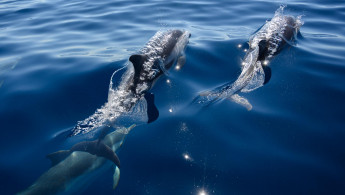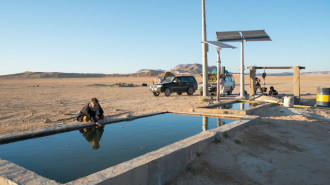Russia may have tested military-trained dolphins in Syria
Satellite images appear to show pens for marine mammals at a Russian naval base in Syria.
2 min read
Both the US and Russia navies train dolphins [Getty]
Russia deployed military-trained dolphins to Syria as part of its campaign to bolster the regime of Bashar al-Assad, a new report has claimed.
Satellite imagery from November 2018 appear to show two marine mammal pens at a Russian naval base in Tartous, according to an investigation carried out by open-source researcher H I Sutton published by Forbes.
The appearance of the pens matches that of pens present at Russian naval bases in the Black Sea and Arctic, according to Sutton, who believes the dolphins were likely deployed from a unit based in the Crimea.
The Russian military's use of marine mammals returned to prominence last year after the appearance of a tame beluga whale off of the coast of Norway.
The beluga, nicknamed Hvaldimir, was wearing a camera harness and seemed to be used to humans, leading to speculation that the animal escaped from a Russian naval facility where it had been trained as a spy.
Although some rebutted the spy theory - positing Hvaldimir was instead a therapy animal which escaped from a now-defunct project - the odd incident put the spotlight on the use of marine mammals by militaries.
The United States trains dolphins and sea lions, mostly in object recovery and mine detection.
The Soviet Union operated a marine mammal research and training facility in Sevastopol, which later became part of Ukraine but is now part of the Russian-occupied Crimean peninsula.
While the programme became defunct after the collapse of the Soviet Union, reports from the past decade indicate that the Crimean research facility was revived and later taken over by Russia after its annexation of the Crimea. The Ukrainian dolphins had been trained to detect underwater mines and unwanted swimmers in restricted waters, according to reports.
Russia has also established a similar facility or facilities along its Arctic coast.
According to Sutton, Russia's alleged use of military-trained dolphins in Syria was only temporary, indicating that it may have been a test.
The two marine mammal pens in Tartous only exist in satellite imagery dated between September and December 2018. The pens are also smaller than those located at other Russian naval bases, Sutton wrote.
Follow us on Facebook, Twitter and Instagram to stay connected
Satellite imagery from November 2018 appear to show two marine mammal pens at a Russian naval base in Tartous, according to an investigation carried out by open-source researcher H I Sutton published by Forbes.
The appearance of the pens matches that of pens present at Russian naval bases in the Black Sea and Arctic, according to Sutton, who believes the dolphins were likely deployed from a unit based in the Crimea.
The Russian military's use of marine mammals returned to prominence last year after the appearance of a tame beluga whale off of the coast of Norway.
The beluga, nicknamed Hvaldimir, was wearing a camera harness and seemed to be used to humans, leading to speculation that the animal escaped from a Russian naval facility where it had been trained as a spy.
Although some rebutted the spy theory - positing Hvaldimir was instead a therapy animal which escaped from a now-defunct project - the odd incident put the spotlight on the use of marine mammals by militaries.
|
|
The United States trains dolphins and sea lions, mostly in object recovery and mine detection.
The Soviet Union operated a marine mammal research and training facility in Sevastopol, which later became part of Ukraine but is now part of the Russian-occupied Crimean peninsula.
While the programme became defunct after the collapse of the Soviet Union, reports from the past decade indicate that the Crimean research facility was revived and later taken over by Russia after its annexation of the Crimea. The Ukrainian dolphins had been trained to detect underwater mines and unwanted swimmers in restricted waters, according to reports.
Russia has also established a similar facility or facilities along its Arctic coast.
According to Sutton, Russia's alleged use of military-trained dolphins in Syria was only temporary, indicating that it may have been a test.
The two marine mammal pens in Tartous only exist in satellite imagery dated between September and December 2018. The pens are also smaller than those located at other Russian naval bases, Sutton wrote.
Follow us on Facebook, Twitter and Instagram to stay connected





 Follow the Middle East's top stories in English at The New Arab on Google News
Follow the Middle East's top stories in English at The New Arab on Google News


